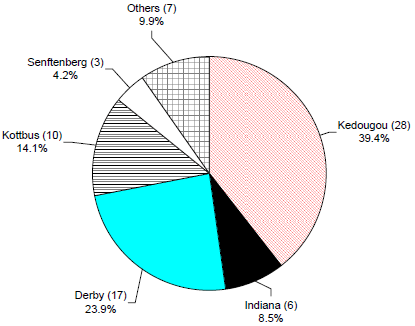



Salmonella in Livestock Production in GB - 2009 - Turkeys
This annual publication from the Veterinary Laboratories Agency provides data on Salmonella reports from livestock species in Great Britain (England, Wales and Scotland). This article covers the chapter entitled 'Reports of Salmonella in Turkeys'.Reports of Salmonella in Turkeys
There was no harmonised statutory monitoring of turkey flocks for Salmonella in 2009 but many turkey producers carry out voluntary monitoring.
The number of incidents of Salmonella reported in turkey flocks increased by 25 per cent, from 57 in 2008 to 71 in 2009. The majority (87.3 per cent) arose through voluntary surveillance activities, while 12.7 per cent of reports were associated with clinical disease. One of the 71 incidents was related to samples taken at a hatchery, while the remainder were from farms.
There was one incident of S. Typhimurium. This remains the same as in 2008. The incident in 2009 involved DT104b; this differs from that found in 2008 (U302), but this phage type had been reported from turkeys previously between 2005 and 2007 (two incidents in 2005, and one in each of 2006 and 2007). In 2009, there were no reports of S. Enteritidis, S. Hadar, S. Infantis or S. Virchow from turkey flocks.
The most common serovar reported was S. Kedougou, accounting for 39.4 per cent of incidents in 2009. This figure is similar to the proportion in 2008 (40.4 per cent of incidents). The second most common serovar was S. Derby, accounting for 23.9 per cent of incidents in turkeys. This represents a reduction compared with 2007 and 2008, during which 34.3 per cent and 35.1 per cent of incidents from turkeys were identified as S. Derby. S. Kottbus and S. Indiana were the third and fourth most common serovars identified in turkeys in 2009 (14.1 per cent and 8.5 per cent of incidents respectively). The latter is an increase from 2008, when just 3.5 per cent of reports were attributed to S. Indiana. Salmonella Senftenberg was the fifth most common serovar, accounting for 4.2 per cent of incidents; this serovar did not appear in 2008, but accounted for 8.3 per cent of incidents in 2007.
S. Bovismorbificans and S. Colindale were reported in 2009, with one incident each. Neither of these serovars had been reported in turkeys prior to 2009. S. Mbandaka and S. Orion were also reported, with one incident each in 2009; neither of these serovars had been reported in turkeys since 2005. There was one incident of S. Montevideo in 2009, similar to 2008.
There were no reports of S. Ohio in 2009 compared with one incident in 2008.
In 2009, there were 37 Salmonella reports of non-GB origin from turkeys. These were 32 reports of S. Kedougou, four reports of S. Indiana and a single report of Salmonella 13,23:i:-. These reports have been excluded from the tables and figures of this publication.
In 2009, the following Salmonella serovars were reported from turkeys for reasons other than routine surveillance, for example through research projects: S. Agama, S. Agona, S. Bardo, S. Durham, S. Newport, S. O rough:e,h:1,2, S. Enteritidis PTs 4, 6 and 9b, and S. Typhimurium phage types DT120, U288, U302 and RDNC.

Further Reading
| - | You can view the full chapter Reports of Salmonella in Turkeys (including detailed tables) by clicking here. |
Further Reading
| - | You can view the full report Salmonella in Livestock Production in GB 2009 by clicking here. |
January 2011








